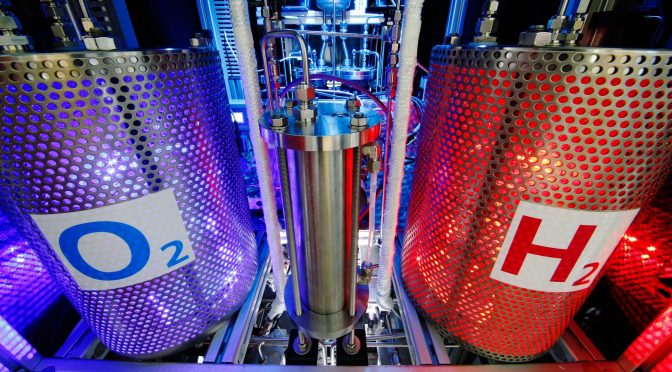The German Aerospace Center (Deutsches Zentrum fuer Luft- und Raumfahrt; DLR) is examining the potential of green hydrogen as a source of energy for a climate-neutral energy system in a two-part study. The first part is considering the technologies and prospects for a sustainable and cost-effective hydrogen supply. The second focuses on the issue of sector coupling. Green hydrogen is sustainable and climate neutral, as it is produced from water and energy from renewable sources such as solar and wind power.
The study pinpoints two factors for the successful establishment of hydrogen as an energy source – consistent sector coupling throughout the entire supply chain, from generation and storage to use; and international cooperation on the production and distribution of this green energy carrier.
“Green hydrogen has the potential to serve as the key building block for an energy and transportation system with massively reduced greenhouse gas emissions. The required technologies have been successfully researched in Germany for some time. Bold approaches are now needed to implement hydrogen on a large scale. Germany can play a globally pioneering role in this area and thus take an important step forward for the protection of Earth’s climate while also raising the country’s profile as a prime location for science and industry. We need to invest in technology and its demonstration, as well as continue to fund basic research and create the necessary conditions for widespread market entry,” explains Karsten Lemmer, DLR Executive Board Member for Energy and Transport.
International solutions for production and logistics
The potential for renewable forms of energy in Germany is limited. Producing hydrogen in countries with more sunshine and wind represents an economically attractive option. In fact, this is the only possible way to ensure that the rapidly growing demand for green hydrogen in the energy, industrial, and mobility sectors can be met. With that in mind, the development of a hydrogen economy that incorporates the necessary logistics should, from the very outset, be geared towards international cooperation both inside and outside of the European Union.
Concentrating solar technologies (CSTs) have the greatest potential for drastically reducing the cost of hydrogen production, as they use solar energy to produce and store heat. This heat can be used to split water into its components – hydrogen and oxygen. DLR is developing components and systems that will allow such technologies to be made as efficient, durable, and suitable for industrial use as possible. This first pilot facilities are already in operation.
As a prime location for science and industry, Germany can greatly benefit from the development and export of technologies that can be used to produce hydrogen and transport it over long distances. The same applies to its technological innovations for solar-thermal power plants and storage solutions.
Prioritising consistent sector coupling
Green hydrogen can only reach its full potential as the second pillar of a sustainable energy system – alongside power generated directly from renewable sources – if the transport, power generation, heating, and industrial sectors are fully coupled. Widespread use of hydrogen will allow its potential for efficiency and flexibility as an energy source to be effectively exploited. Future investments should therefore focus on the energy system as a whole, rather than concentrating on individual applications. One example of this type of sector coupling is found in the operation of vehicles powered by fuel cells, which use hydrogen to generate power for their electric power trains. DLR is working on solutions that will also allow these vehicles to feed power into the grid when required. The use of electrolysis systems to produce hydrogen is another example, as the waste heat from this process can be used in local heating networks.
Generating momentum through research
The DLR study recommends three key areas of research in the field of hydrogen generation to ensure that Germany is able to take on a leading role in technology development. Firstly, the development and expansion of demonstration facilities for hydrogen production within the framework of international collaboration; secondly, the development of materials and processes for electrolysers, with a particular focus on automated production; and thirdly, the ongoing development of innovative hydrogen production processes, including those based on solar-thermal energy, and with a major emphasis on scalability, production costs, and greenhouse gas emissions throughout the entire value chain.
In terms of sector coupling, the DLR study also proposes three key areas of focus for research. Firstly, upgrading the existing infrastructure for storing and transporting gaseous sources of energy, so that these can also be used with hydrogen admixtures and later with pure hydrogen; secondly, researching the possible integration of the electrical and digital systems used by hydrogen technologies at all levels of the energy system, such as by incorporating hydrogen into construction technology; and thirdly, developing better models and evaluation methods that are capable of reliably portraying the entire energy system and thus help businesses and policy-makers to make optimal economic decisions.
DLR energy research – controllable, sustainable energy
The energy system of the future must be able to provide controllable, sustainable and cost-effective power to households, transportation and industry. DLR’s energy research focuses on achieving this goal. DLR scientists are investigating and developing materials, processes, and technologies that will allow efficient use of solar and wind energy. At DLR, the aim of its research into energy systems is to improve understanding of the overall energy system of the future, to design it in the best possible way, to ensure that it will be reliable and cost-effective to run, and to identify approaches for its continued development and management.


